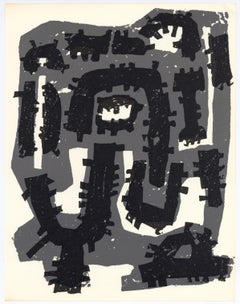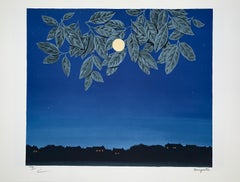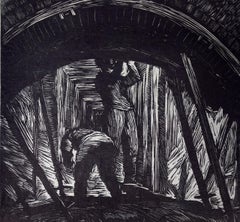Raoul Ubac Figurative Prints
Belgian, 1910-1985
Born in 1910, Raoul Ubac is an artist from the New Ecole in Paris.
Raoul Ubac spent his early childhood in Germany (Prussia) between Cologne and Frankfurt.He returned to Paris in 1930 and enrolled in the Sorbonne.Then he met André Breton and frequented the surrealists and artists of Montparnasse.He undertook numerous trips across Europe and photographed the island of Hvar (now Croatia) of found stone assemblies.
Then, on the advice of Otto Freundlich, German painter and sculptor, he enrolled in the School of Applied Arts where he worked in drawing and photography.First of all, he is most interested in photography and is experimenting with processes of burning, solarization and petrification. He participated in the activities of the surrealists and exhibited under the pseudonym of Raoul Michelet at the Exposition Internationale du Surreéalisme in 1935, the first surrealist exhibition taking place in Belgium.
From 1936 he learned engraving in the studio of artist Stanley William Hayter and began to make photomontages.In 1970 he founded the magazine «L'invention collective» with René Magritte and then collaborated in the magazine «Messages» where he met Raymond Queneau and Paul Eluard. After the war, he gradually moved away from surrealism and abandoned photography.
Raoul Ubac then embarks on drawing with a pen to create to launch himself in drawing with a feather and then engraving on slate to make gouaches, and ends up approaching the painting with an egg.He paints on panels covered with amalgamated resins which constitute a synthesis of his work and his research, dealing with the themes of bodies and furrows, subjects of predilection until his death.
In 1968 a retrospective of his work was presented in Brussels and at the Musée d'art moderne in Paris. Raoul Ubac received the Grand Prix national des arts in 1973. He was responsible for several sets of stained glass windows as well as reliefs, high reliefs, wall decorations and models of tapestries for public and private buildings. He has also illustrated with his drawings, engravings and lithographs some thirty books and is the author of the cover of the journal «Argile» published by Maeght from 1973 to 1981.
Ubac’s works are part of many collections of museums in France and Europe. In 1980, the French Post Office issued a stamp reproducing one of its creations.
Raoul Ubac died on March 24, 1985.to
2
Overall Width
to
Overall Height
to
1
42
838
382
377
308
2
1
2
1
1
1
1
1
Artist: Raoul Ubac
original woodcut
By Raoul Ubac
Located in Henderson, NV
Medium: original woodcut. This original Raoul Ubac woodcut was issued in 1958 for the hard-to-find XXe Siecle (No. 10), published in Paris by San Lazzaro. Sheet size 12 3/8 x 9 1/2 i...
Category
1950s Raoul Ubac Figurative Prints
Materials
Woodcut
Surrealist Figure - Handsigned Original Lithograph
By Raoul Ubac
Located in Paris, IDF
Raoul UBAC
Surrealist Figure
Original lithograph
Handsigned in pencil
On Japan paper, 40,5 x 31,5 cm (c. 15,9 x 12,4 inch)
Excellent condition
Category
Late 20th Century Surrealist Raoul Ubac Figurative Prints
Materials
Lithograph
Related Items
La Page Blanche - 20th Century, Surrealist, Lithograph, Figurative Print
By (after) René Magritte
Located in Sint-Truiden, BE
Numbered: 138/275
Color lithograph after the 1967 oil on canvas by René Magritte, printed signature of Magritte and numbered from the edition of 275.
The lithograph features the dry...
Category
20th Century Surrealist Raoul Ubac Figurative Prints
Materials
Lithograph
$996
H 23.63 in W 17.72 in
"Mine Shaft", Soviet Union: An Early 20th C. Woodcut Engraving by Abramovitz
By Albert Abramovitz
Located in Alamo, CA
This is a signed woodcut engraving entitled "Mine Shaft" created by Albert Abramovitz in 1935, after a trip to the Soviet Union. It depicts two Russian workers constructing a mine sh...
Category
1930s Raoul Ubac Figurative Prints
Materials
Woodcut
$1,175
H 13.38 in W 8.88 in
Untitled
By Kiki Smith
Located in New York, NY
Kiki Smith
'Untitled,' 1995
Woodcut with color additions by hand
31 x 21 inches
Edition 43 of 47
Signed
In 1995 five well-known American artists - Donald Baechler, Julian Lethbridge...
Category
1990s Raoul Ubac Figurative Prints
Materials
Woodcut
René Magritte - LE DOMAINE D'ARNHEIM Limited Surrealism French Contemporary
By (after) René Magritte
Located in Madrid, Madrid
René Magritte - LE DOMAINE D'ARNHEIM, 1962 (THE DOMAIN OF ARNHEIM)
Date of creation: 2010
Medium: Lithograph on BFK Rives Paper
Edition number: 155/275
Size: 60 x 45 cm
Condition: Ne...
Category
Mid-20th Century Surrealist Raoul Ubac Figurative Prints
Materials
Paper, Lithograph
$1,166
H 23.63 in W 17.72 in
Boy and puppy
Located in Belgrade, MT
Madeline Luka (French 1894-1989) was a self taught painter known for her landscapes, portraits, nudes and still lifes. She typically portrayed her family and close friends set within...
Category
Mid-20th Century Surrealist Raoul Ubac Figurative Prints
Materials
Lithograph
RENÉ MAGRITTE LA GRANDE FAMILLE, 1963 Limited edition Lithograph - Surrealism
By (after) René Magritte
Located in Madrid, Madrid
LA GRANDE FAMILLE, 1963 (THE LARGE FAMILY)
Date of creation: 2010
Medium: Lithograph on BFK Rives Paper
Edition: 275
Size: 60 x 45 cm
Observations: Lithograph on BFK Rives paper plat...
Category
Mid-20th Century Surrealist Raoul Ubac Figurative Prints
Materials
Lithograph
$1,168
H 23.63 in W 17.72 in D 0.08 in
RENÉ MAGRITTE: LA MAGIE NOIRE, 1945 - Limited edition Lithograph Surrealism
By (after) René Magritte
Located in Madrid, Madrid
LA MAGIE NOIRE, 1945 (BLACK MAGIC)
Date of creation: 2010
Medium: Lithograph on BFK Rives Paper
Edition: 275
Size: 60 x 45 cm
Observations: Lithograph on BFK Rives paper plate signed...
Category
Mid-20th Century Surrealist Raoul Ubac Figurative Prints
Materials
Lithograph
$1,168
H 17.72 in W 23.63 in
Midnight Wolf: A Limited Edition Clarence Mills Signed Haida Inuit Print
Located in Alamo, CA
"Midnight Wolf" is a framed signed limited edition abstract inuit native people's work by Northwest Coast Haida artist Clarence Mills. The print depicts a st...
Category
Late 20th Century Abstract Raoul Ubac Figurative Prints
Materials
Woodcut
$1,075
H 26.88 in W 20.63 in D 0.88 in
RENÉ MAGRITTE L'EMPIRE DES LUMIÈRES, 1964 Limited edition Lithograph, Surrealism
By (after) René Magritte
Located in Madrid, Madrid
L'EMPIRE DES LUMIÈRES, 1964 (THE EMPIRE OF LIGHTS, 1964)
Date of creation: 2010
Medium: Lithograph on BFK Rives Paper
Edition: 275
Size: 60 x 45 cm
Observations: Lithograph on BFK Ri...
Category
Mid-20th Century Surrealist Raoul Ubac Figurative Prints
Materials
Lithograph
$1,168
H 23.63 in W 17.72 in D 0.08 in
untitled, original
By Paul Colin
Located in Belgrade, MT
This piece is a limited edition, pencil signed by the artist on the print and in the plate. It is part of my private collection of artists from the School of Paris era. It is in very...
Category
Mid-20th Century Surrealist Raoul Ubac Figurative Prints
Materials
Engraving, Lithograph
Alex Katz from 'A Tremor in the Morning' signed, limited edition woodcut print
By Alex Katz
Located in San Rafael, CA
Alex Katz (b. 1927)
Untitled, from the portfolio 'A Tremor in the Morning', 1986
Woodcut on wove paper
Edition 32/45
Signed and numbered in pencil lower left
Sheet: 20 x 19.75 inches...
Category
1980s Contemporary Raoul Ubac Figurative Prints
Materials
Lithograph, Woodcut
$4,800
H 22.5 in W 22 in D 1.5 in
Fisherman
Located in Belgrade, MT
This etching by Lucien Coutard is part of my private collection since the 1970's. It is signed. Lucien Courtard created surrealist depictions of sexuality, he called it Eroticism and...
Category
Mid-20th Century Surrealist Raoul Ubac Figurative Prints
Materials
Etching, Lithograph
Raoul Ubac figurative prints for sale on 1stDibs.
Find a wide variety of authentic Raoul Ubac figurative prints available for sale on 1stDibs. You can also browse by medium to find art by Raoul Ubac in lithograph, woodcut print and more. Much of the original work by this artist or collective was created during the 20th century and is mostly associated with the Surrealist style. Not every interior allows for large Raoul Ubac figurative prints, so small editions measuring 10 inches across are available. Customers who are interested in this artist might also find the work of Paul Delvaux, Maurice Pasternak, and René Magritte. Raoul Ubac figurative prints prices can differ depending upon medium, time period and other attributes. On 1stDibs, the price for these items starts at $150 and tops out at $323, while the average work can sell for $237.


